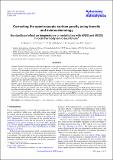Correcting the spectroscopic surface gravity using transits and asteroseismology : no significant effect on temperatures or metallicities with ARES and MOOG in local thermodynamic equilibrium
Abstract
Context. Precise stellar parameters (effective temperature, surface gravity, metallicity, stellar mass, and radius) are crucial for several reasons, amongst which are the precise characterization of orbiting exoplanets and the correct determination of galactic chemical evolution. The atmospheric parameters are extremely important because all the other stellar parameters depend on them. Using our standard equivalent-width method on high-resolution spectroscopy, good precision can be obtained for the derived effective temperature and metallicity. The surface gravity, however, is usually not well constrained with spectroscopy. Aims. We use two different samples of FGK dwarfs to study the effect of the stellar surface gravity on the precise spectroscopic determination of the other atmospheric parameters. Furthermore, we present a straightforward formula for correcting the spectroscopic surface gravities derived by our method and with our linelists. Methods. Our spectroscopic analysis is based on Kurucz models in local thermodynamic equilibrium, performed with the MOOG code to derive the atmospheric parameters. The surface gravity was either left free or fixed to a predetermined value. The latter is either obtained through a photometric transit light curve or derived using asteroseismology. Results. We find first that, despite some minor trends, the effective temperatures and metallicities for FGK dwarfs derived with the described method and linelists are, in most cases, only affected within the errorbars by using different values for the surface gravity, even for very large differences in surface gravity, so they can be trusted. The temperatures derived with a fixed surface gravity continue to be compatible within 1 sigma with the accurate results of the infrared flux method (IRFM), as is the case for the unconstrained temperatures. Secondly, we find that the spectroscopic surface gravity can easily be corrected to a more accurate value using a linear function with the effective temperature.
Citation
Mortier , A , Sousa , S G , Adibekyan , V Z , Brandão , I M & Santos , N C 2014 , ' Correcting the spectroscopic surface gravity using transits and asteroseismology : no significant effect on temperatures or metallicities with ARES and MOOG in local thermodynamic equilibrium ' , Astronomy & Astrophysics , vol. 572 , A95 . https://doi.org/10.1051/0004-6361/201424537
Publication
Astronomy & Astrophysics
Status
Peer reviewed
ISSN
0004-6361Type
Journal article
Description
This work was supported by the European Research Council/European Community under the FP7 through Starting Grant agreement number 239953. N.C.S. was supported by FCT through the Investigador FCT contract reference IF/00169/2012 and POPH/FSE (EC) by FEDER funding through the program Programa Operacional de Factores de Competitividade – COMPETE. V.Zh.A., S.G.S., and I.M.B. acknowledge the support of the Fundação para a Ciência e a Tecnologia (FCT) in the form of grant references SFRH/BPD/70574/2010, SFRH/BPD/47611/2008, and SFRH/BPD/87857/2012.Collections
Items in the St Andrews Research Repository are protected by copyright, with all rights reserved, unless otherwise indicated.

